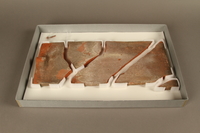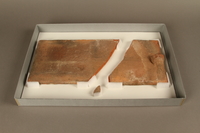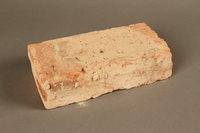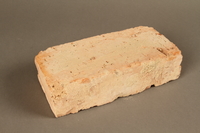Overview
- Brief Narrative
- Brick from a brick factory in Kőszeg, Hungary. Jewish residency in the town began in the 14th century and continued for five hundred years. From 1919 to 1921, Jews in Kőszeg and throughout Hungary were targeted by the White Terror pogroms for their perceived association with communism. Leading up to World War II, the Jewish population in the town was approximately 100 people. In December 1940, a forced labor camp was established with Jewish and non-Jewish workers at a brick field and an old brewery in the town. The camp housed eight thousand laborers who were forced to march 10 kilometers to and from work. They worked 10 hour days, 7 days a week, with only a daily ration of 17 ounces of bread. In March 1944, Germany occupied Hungary and the Jews of Kőszeg along with other Jews from the surrounding area were confined to a small ghetto in the town. On July 4, the remaining Kőszeg Jews were deported to Auschwitz-Birkenau killing center in German occupied Poland. In March 1945, the Germans liquidated the labor camp. As part of the liquidation, 95 sick laborers were locked in a sealed barrack and gassed to death on the property of Kőszeg Varosi Teglagyàr (Kőszeg Urban Brickworks), one of two brick factories in the town. In 1985, a park and a memorial were erected on the former property of the brick factory where the execution took place.
- Date
-
manufacture:
approximately 1850-2015
- Geography
-
manufacture:
Kőszeg (Hungary)
- Credit Line
- United States Holocaust Memorial Museum Collection, Gift of the Municipality of Köszeg
Physical Details
- Classification
-
Materials
- Category
-
Building materials
- Object Type
-
Bricks (lcsh)
- Genre/Form
- Bricks.
- Physical Description
- Rectangular, light red, clay brick with a flat, coarse, pitted surface. The surface has several small cracks, and the right and front sides are uneven and rough. There are several small losses in the front. The back and front have a thin, partial layer of gray mortar covering the surface. Part of the top surface is darkly stained.
- Dimensions
- overall: Height: 2.750 inches (6.985 cm) | Width: 10.000 inches (25.4 cm) | Depth: 4.750 inches (12.065 cm)
- Materials
- overall : brick, mortar
Rights & Restrictions
- Conditions on Access
- No restrictions on access
- Conditions on Use
- No restrictions on use
Keywords & Subjects
- Topical Term
- Holocaust, Jewish (1939-1945)--Hungary. Kőszeg (Hungary)--History. Jews--Hungary--History. Manufacturing industries--Hungary. Execution sites. Executions and executioners--Hungary--History. Forced Labor--Hungary.
- Geographic Name
- Kőszeg (Hungary) Kőszegfalva (Kőszeg, Hungary)
- Corporate Name
- Koszeg (Concentration camp)
Administrative Notes
- Legal Status
- Permanent Collection
- Provenance
- The brick was donated to the United States Holocaust Memorial Museum in 2017 by the Municipality of Kőszeg.
- Record last modified:
- 2024-02-21 07:11:15
- This page:
- https://collections.ushmm.org/search/catalog/irn564943
Download & Licensing
In-Person Research
- By Appointment
- Request 21 Days in Advance of Visit
- Plan a Research Visit
- Request to See This Object
Contact Us
Also in Kőszeg brick factory collection
The collection consists of two broken tiles and four bricks from a local brick factory relating to events in the area of Kőszeg, Hungary, during the Holocaust
Date: approximately 1850-2015

Broken red clay tile from a brick factory in Kőszeg, Hungary
Object
Tile from a brick factory in Kőszeg, Hungary. Jewish residency in the town began in the 14th century and continued for five hundred years. From 1919 to 1921, Jews in Kőszeg and throughout Hungary were targeted by the White Terror pogroms for their perceived association with communism. Leading up to World War II, the Jewish population in the town was approximately 100 people. In December 1940, a forced labor camp was established with Jewish and non-Jewish workers at a brick field and an old brewery in the town. The camp housed eight thousand laborers who were forced to march 10 kilometers to and from work. They worked 10 hour days, 7 days a week, with only a daily ration of 17 ounces of bread. In March 1944, Germany occupied Hungary and the Jews of Kőszeg along with other Jews from the surrounding area were confined to a small ghetto in the town. On July 4, the remaining Kőszeg Jews were deported to Auschwitz-Birkenau killing center in German occupied Poland. In March 1945, the Germans liquidated the labor camp. As part of the liquidation, 95 sick laborers were locked in a sealed barrack and gassed to death on the property of Kőszeg Varosi Teglagyàr (Kőszeg Urban Brickworks), one of two brick factories in the town. In 1985, a park and a memorial were erected on the former property of the brick factory where the execution took place.

Broken red clay tile from a brick factory in Kőszeg, Hungary
Object
Tile from a brick factory in Kőszeg, Hungary. Jewish residency in the town began in the 14th century and continued for five hundred years. From 1919 to 1921, Jews in Kőszeg and throughout Hungary were targeted by the White Terror pogroms for their perceived association with communism. Leading up to World War II, the Jewish population in the town was approximately 100 people. In December 1940, a forced labor camp was established with Jewish and non-Jewish workers at a brick field and an old brewery in the town. The camp housed eight thousand laborers who were forced to march 10 kilometers to and from work. They worked 10 hour days, 7 days a week, with only a daily ration of 17 ounces of bread. In March 1944, Germany occupied Hungary and the Jews of Kőszeg along with other Jews from the surrounding area were confined to a small ghetto in the town. On July 4, the remaining Kőszeg Jews were deported to Auschwitz-Birkenau killing center in German occupied Poland. In March 1945, the Germans liquidated the labor camp. As part of the liquidation, 95 sick laborers were locked in a sealed barrack and gassed to death on the property of Kőszeg Varosi Teglagyàr (Kőszeg Urban Brickworks), one of two brick factories in the town. In 1985, a park and a memorial were erected on the former property of the brick factory where the execution took place.

Brick from a factory in Kőszeg, Hungary
Object
Brick from a brick factory in Kőszeg, Hungary. Jewish residency in the town began in the 14th century and continued for five hundred years. From 1919 to 1921, Jews in Kőszeg and throughout Hungary were targeted by the White Terror pogroms for their perceived association with communism. Leading up to World War II, the Jewish population in the town was approximately 100 people. In December 1940, a forced labor camp was established with Jewish and non-Jewish workers at a brick field and an old brewery in the town. The camp housed eight thousand laborers who were forced to march 10 kilometers to and from work. They worked 10 hour days, 7 days a week, with only a daily ration of 17 ounces of bread. In March 1944, Germany occupied Hungary and the Jews of Kőszeg along with other Jews from the surrounding area were confined to a small ghetto in the town. On July 4, the remaining Kőszeg Jews were deported to Auschwitz-Birkenau killing center in German occupied Poland. In March 1945, the Germans liquidated the labor camp. As part of the liquidation, 95 sick laborers were locked in a sealed barrack and gassed to death on the property of Kőszeg Varosi Teglagyàr (Kőszeg Urban Brickworks), one of two brick factories in the town. In 1985, a park and a memorial were erected on the former property of the brick factory where the execution took place.

Brick from a factory in Kőszeg, Hungary
Object
Brick from a brick factory in Kőszeg, Hungary. Jewish residency in the town began in the 14th century and continued for five hundred years. From 1919 to 1921, Jews in Kőszeg and throughout Hungary were targeted by the White Terror pogroms for their perceived association with communism. Leading up to World War II, the Jewish population in the town was approximately 100 people. In December 1940, a forced labor camp was established with Jewish and non-Jewish workers at a brick field and an old brewery in the town. The camp housed eight thousand laborers who were forced to march 10 kilometers to and from work. They worked 10 hour days, 7 days a week, with only a daily ration of 17 ounces of bread. In March 1944, Germany occupied Hungary and the Jews of Kőszeg along with other Jews from the surrounding area were confined to a small ghetto in the town. On July 4, the remaining Kőszeg Jews were deported to Auschwitz-Birkenau killing center in German occupied Poland. In March 1945, the Germans liquidated the labor camp. As part of the liquidation, 95 sick laborers were locked in a sealed barrack and gassed to death on the property of Kőszeg Varosi Teglagyàr (Kőszeg Urban Brickworks), one of two brick factories in the town. In 1985, a park and a memorial were erected on the former property of the brick factory where the execution took place.

Brick from a factory in Kőszeg, Hungary
Object
Brick from a brick factory in Kőszeg, Hungary. Jewish residency in the town began in the 14th century and continued for five hundred years. From 1919 to 1921, Jews in Kőszeg and throughout Hungary were targeted by the White Terror pogroms for their perceived association with communism. Leading up to World War II, the Jewish population in the town was approximately 100 people. In December 1940, a forced labor camp was established with Jewish and non-Jewish workers at a brick field and an old brewery in the town. The camp housed eight thousand laborers who were forced to march 10 kilometers to and from work. They worked 10 hour days, 7 days a week, with only a daily ration of 17 ounces of bread. In March 1944, Germany occupied Hungary and the Jews of Kőszeg along with other Jews from the surrounding area were confined to a small ghetto in the town. On July 4, the remaining Kőszeg Jews were deported to Auschwitz-Birkenau killing center in German occupied Poland. In March 1945, the Germans liquidated the labor camp. As part of the liquidation, 95 sick laborers were locked in a sealed barrack and gassed to death on the property of Kőszeg Varosi Teglagyàr (Kőszeg Urban Brickworks), one of two brick factories in the town. In 1985, a park and a memorial were erected on the former property of the brick factory where the execution took place.



